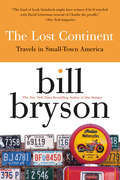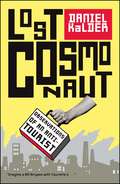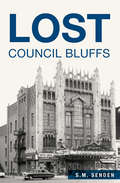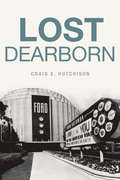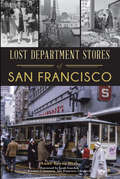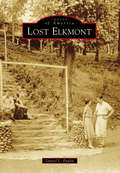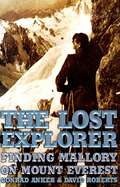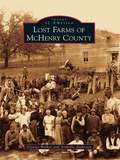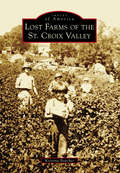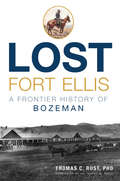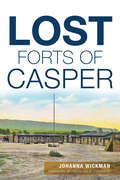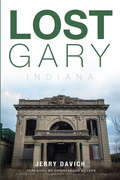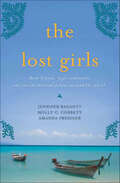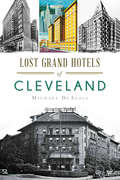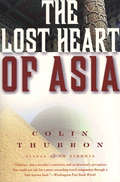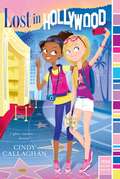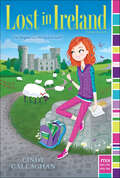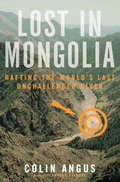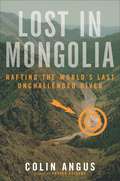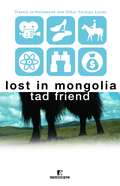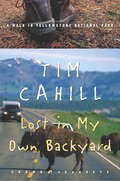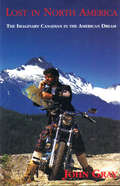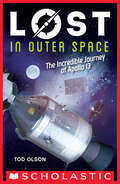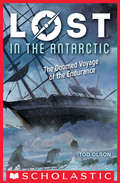- Table View
- List View
The Lost Continent
by Bill BrysonAn unsparing and hilarious account of one man's rediscovery of America and his search for the perfect small town.
The Lost Continent: Travels in Small-Town America
by Bill BrysonFrom the Publisher: An unsparing and hilarious account of one man's rediscovery of America and his search for the perfect small town.
Lost Cosmonaut: Observations of an Anti-Tourist
by Daniel KalderDaniel Kalder belongs to a unique group: the anti-tourists. Sworn to uphold the mysterious tenets ofThe Shymkent Declarations, the anti-tourist seeks out the dark, lost zones of our planet, eschewing comfort, embracing hunger and hallucinations, and always traveling at the wrong time of year. In Lost Cosmonaut, Kalder visits locations that most of us don't even know exist -- Tatarstan, Kalmykia, Mari El, and Udmurtia. He loves these places because no one else does, because everyone else passes them by. A tale of adventure, conversation, boredom, and observation -- occasionally enhanced by an overactive imagination -- Kalder reveals a world of hidden cities, lost rites, mail-order brides, machine guns, mutants, and cold, cold emptiness. In the desert wastelands of Kalmykia, he stumbles upon New Vasyuki, the only city in the world dedicated to chess. In Mari El, home to Europe's last pagan nation, he meets the chief Druid and participates in an ancient rite; while in the bleak industrial badlands of Udmurtia, Kalder searches for Mikhail Kalashnikov, inventor of the AK-47, and inadvertently becomes a TV star. An unorthodox mix of extraordinary stories woven together with fascinating history, peculiar places, and even stranger people,Lost Cosmonautis poetic and profane, hilarious and yet oddly heartwarming, bizarre and even educational. In short, it's the perfect guide to the most alien planet in our cosmos: Earth.
Lost Council Bluffs (Lost)
by S. M. SendenNestled in the Loess Hills, Council Bluffs grew from a frontier settlement of wickiups and log cabins. The outpost boomed as a gateway to the West when gold was discovered in California in 1849. The Pacific House and the Ogden House became landmark hotels for the transient population. Meanwhile, residents thrived and cultivated a bustling city with the Masonic Hall, Dohany's Opera House and the Merriam block. None of these once iconic buildings remains today. Author S.M. Senden explores the perpetual rebirth of Council Bluffs through its most important buildings and relates a still unfolding story.
Lost Dearborn (Lost)
by Craig E. HutchisonThroughout its existence, Dearborn has been a pioneer settlement, a multicultural hub, a college town, a major tourism center and a world-renowned industrial city. Unfortunately, due to a variety of factors, significant structures have been lost to time. Almost all of the eleven U.S. Arsenal complex buildings have disappeared since the arsenal was closed in 1875. The hallways of the Edison School and Oxford School still live on in the hearts of their students but were razed long ago. Even beloved edifices such as the Ford Rotunda and the Ford Motor Company Administration building, built by Dearborn's favorite son, Henry Ford, are now only a memory. Author Craig E. Hutchison endeavors to immortalize the important foundational building blocks of an evolving city.
Lost Department Stores of San Francisco (Landmarks)
by Anne Evers HitzIn the late nineteenth century, San Francisco's merchant princes built grand stores for a booming city, each with its own niche. For the eager clientele, a trip downtown meant dressing up--hats, gloves and stockings required--and going to Blum's for Coffee Crunch cake or Townsend's for creamed spinach. The I. Magnin empire catered to a selective upper-class clientele, while middle-class shoppers loved the Emporium department store with its Bargain Basement and Santa for the kids. Gump's defined good taste, the City of Paris satisfied desires for anything French and edgy, youth-oriented Joseph Magnin ensnared the younger shoppers with the latest trends. Join author Anne Evers Hitz as she looks back at the colorful personalities that created six major stores and defined shopping in San Francisco.
Lost Elkmont (Images of America)
by Daniel L. PaulinPrior to the formation of the Great Smoky Mountains National Park (GSMNP) in 1934, the small community of Elkmont was established as a logging camp by Col. Wilson B. Townsend's Little River Lumber Company around 1908. This was after he purchased 86,000 acres of mostly virgin forest. The area that was previously inhabited by various American Indian groups, and later by European-American settlers beginning around 1830, was to become for a time the second largest town in Sevier County, Tennessee. Colonel Townsend's business ventures proved successful beyond expectation, as he skillfully exploited the area's valuable hardwood forests. His logging company and railroad provided a mountain population with jobs and steady wages. Once all the valuable timber was harvested, Townsend sold land to private citizens who established what was to become an exclusive summer community that included both the Appalachian and Wonderland Clubs. These coexisted inside the GSMNP until 1992. This is the story of Elkmont.
The Lost Explorer
by David Roberts Conrad AnkerThis is the adventure story of the year -- how Conrad Anker found the body of George Mallory on Mount Everest, casting an entirely new light on the mystery of the explorer who may have conquered Everest seventy-five years ago. On June 8, 1924, George Leigh Mallory and Andrew "Sandy" Irvine were last seen climbing toward the summit of Mount Everest. Clouds soon closed around them, and they vanished into history. Ever since, mountaineers have wondered whether they reached the summit twenty-nine years before Edmund Hillary and Tenzing Norgay. On May 1, 1999, Conrad Anker, one of the world's strongest mountaineers, discovered Mallory's body lying facedown, frozen into the scree and naturally mummified at 27,000 feet on Everest's north face. The condition of the body, as well as the artifacts found with Mallory, including goggles, an altimeter, and a carefully wrapped bundle of personal letters, are important clues in determining his fate. Seventeen days later, Anker free-climbed the Second Step, a 90-foot sheer cliff that is the single hardest obstacle on the north ridge. The first expedition known to have conquered the Second Step, a Chinese team in 1975, had tied a ladder to the cliff, leaving unanswered the question of whether Mallory could have climbed it in 1924. Anker's climb was the first test since Mallory's of the cliff's true difficulty. In treacherous conditions, Anker led teammate Dave Hahn from the Second Step to the summit. Reflecting on the climb, Anker explains why he thinks Mallory and Irvine failed to make the summit, but at the same time, he expresses his awe at Mallory's achievement with the primitive equipment of the time. Stunningly handsome and charismatic, Mallory charmed everyone who met him during his lifetime and continues to fascinate mountaineers today. He was an able writer, a favorite of the Bloomsbury circle, and a climber of legendary gracefulness. The Lost Exploreris the remarkable story of this extraordinarily talented man and of the equally talented modern climber who spearheaded a discovery that may ultimately help solve the mystery of Mallory's disappearance.
Lost Farms of McHenry County
by Arabella Anderson Glynnis WalkerFarmers from the East found the broad and fertile prairies of McHenry County offered the perfect soil and climate for growing corn, wheat, oats, barley, and rye. This led the way for a flourishing dairy industry that eventually supplied milk to the city of Chicago. The first settlements appeared in 1835 in towns such as Crystal Lake, Woodstock, Harvard, and Cary. Families such as the Walkups, the Crandalls, the Beardsleys, the Stickneys, and the Terwilligers travelled by oxcart and rode on horseback from distant states. As word of the lush countryside spread, other farmers came from England, Ireland, and Germany to plow the fertile fields of the nation's heartland.
Lost Farms of the St. Croix Valley (Images of America)
by Kristina BoucherThe St. Croix Valley has been a haven for farmers since the first boom in the 1850s. The St. Croix River was a mecca for early industry, and the vast Minnesota and Wisconsin prairies have provided the natural resources for the region’s farmers to grow their crops and their families. The valley was dotted with brightly painted barns, a sign of economic success. However, as time wore on, the St. Croix Valley experienced an agricultural downturn. Barns have been left abandoned. Fields have been turned into subdivisions. An era has passed, and the barns and farms that were once proud reminders of the region’s success are disappearing from the countryside. But why? Lost Farms of the St. Croix Valley explores the history of the region, shares the photographs and stories of local farmers, and evaluates why the traditional family farm is falling by the wayside.
Lost Fort Ellis: A Frontier History of Bozeman (Lost)
by Thomas C. Rust Dr Harry FritzEstablished in 1867 in the Gallatin Valley of Montana, Fort Ellis played a key role in the development of the Montana frontier. From post commanders attacking the town to restoring order when riotous mobs got out of control, explore the ambivalent, albeit contentious, relationship from 1867 to 1886 between the civilians and soldiers in whimsical but dramatic fashion. Competing visions of economic and military conditions on the frontier led to a complex relationship that has all the drama of a Hollywood western. Join MSU-Billings history professor Dr. Thomas C. Rust as he examines the fort's impact on the social and economic development of early Bozeman, the problems of military command and the dynamics of the soldier-civilian interaction on Montana's frontier.
Lost Forts of Casper (Lost)
by Douglas R. Cubbison Johanna WickmanThree army outposts built before and during the Civil War protected critical routes along the western trails at the North Platte River near what later became Casper. All had been abandoned by 1867, and their dramatic stories are mostly forgotten. The Post at Platte Bridge was a vital outpost on Albert Sidney Johnston's Utah War supply route. Camp Dodge and Platte Bridge Station, also called Fort Caspar, guarded telegraph lines from Native American sabotage. Violent winds, horrendous blizzards and scorching summers made life miserable. Tension reached a fever pitch at the Battle of Platte Bridge when Sioux, Cheyenne and Arapaho attacked a cavalry detachment led by Caspar Collins. Today, a reconstructed Fort Caspar stands as a vigilant reminder of the struggles at those lonely frontier stations. Local historian Johanna Wickman chronicles military efforts to keep the peace, wage war and merely survive.
Lost Gary, Indiana (Lost)
by Jerry DavichA poster child for our nation's urban experimentation a century ago, Gary was forged with hype and hope, dreams and sweat, political agendas and tons of steel. The hardscrabble city attracted all kinds, from shady scoundrels and famous architects to hardworking immigrants and brilliant entrepreneurs. Boasting 180,000 residents at its peak, the booming melting pot eventually faded away under the afflictions of urban decay, racial unrest and political upheaval. Jerry Davich explores the remnants of Gary's glory days, from Union Station in ruins to City Methodist Church stripped of its soul. Revisit the Sheraton Hotel's demise, Emerson High School's hard lessons, Vee-Jay Records' last release and a devastated downtown filled only with façades and fond memories.
The Lost Girls: Three Friends. Four Continents. One Unconventional Detour Around the World.
by Jennifer Baggett Holly C. Corbett Amanda Pressner“A triumphant journey about losing yourself, finding yourself and coming home again. Hitch yourself to their ride: you’ll embark on a transformative journey of your own.” — Allison Winn Scotch, New York Times bestselling author of The One That I Want and Time of My LifeThree friends, each on the brink of a quarter-life crisis, make a pact to quit their high pressure New York City media jobs and leave behind their friends, boyfriends, and everything familiar to embark on a year-long backpacking adventure around the world in The Lost Girls.With their thirtieth birthdays looming, Jen, Holly, and Amanda are feeling the pressure to hit certain milestones—score the big promotion, find a soul mate, have 2.2 kids. Instead, they make a pact to quit their jobs and set out on a journey in search of inspiration and direction.Traveling 60,000 miles across four continents, Jen, Holly, and Amanda push themselves far outside their comfort zones to embrace every adventure. Ultimately, theirs is a story of true friendship—a bond forged by sharing beds and backpacks, enduring exotic illnesses, trekking across mountains, and standing by one another through heartaches, whirlwind romances, and everything in the world in between.
Lost Grand Hotels of Cleveland (Landmarks)
by Michael DeAloiaDuring Cleveland's heyday, the world's most influential businessmen, politicians and entertainers flocked to America's sixth-largest city, enjoying the full hospitality of splendid hotels befitting a first-rate metropolis. Marked by architectural splendor, sumptuous design, technical innovation and world-class service, these grand palaces rose and fell with Cleveland's fortunes. From Teddy Roosevelt dining under the ornate chandeliers of the Hotel Hollenden's famed Crystal Ballroom to Bob Hope and Jack Benny cracking wise at the Alcazar's bar, Michael DeAloia adds atmosphere to seven of the most elegant and inviting Cleveland hotels to emerge in the early twentieth century. Only one of these legendary establishments hosts guests today. This revealing chronicle recaptures the golden age of Cleveland's power and prestige.
The Lost Heart of Asia
by Colin ThubronA land of enormous proportions, countless secrets, and incredible history, Central Asia was the heart of the great Mongol empire of Tamerlane and scene of Stalin's cruelest deportations. A remote and fascinating region in a constant state of transition-never more so than since the collapse of the Soviet Union-it encompasses terrain as diverse as the Kazakh steppes, the Karakum desert, and the Pamir mountains. In The Lost Heart of Asia, acclaimed, bestselling travel writer Colin Thubron carries readers on an extraordinary journey through this little understood, rarely visited, yet increasingly important corner of the world.
Lost in Hollywood
by Cindy CallaghanGinger is on a mission to find her family's missing fortune in glamorous Hollywood in this M!X novel from the author of Lost in London, Lost in Paris, Lost in Rome, and Lost in Ireland (formerly titled Lucky Me).Thirteen-year-old Ginger Carlson feels like she is the only normal one in her family. Her father is an inventor who sells his gadgets online, Mom is obsessed with classic movies, and her brother Grant thinks he is from outer space. Luckily, Ginger has a totally normal BFF, Payton, and they have big plans for the future--they plan to become doctors and open a practice together in a big city. But first, they're partnering on the state Science Olympics where they're sure to take home the gold for their eighth grade class with their model of the brain. The Olympics training is interrupted when the Carlson family gets an urgent call that their eccentric Aunt Betty, a former actress who lives in Hollywood, is in serious trouble. The bank is going to take her house unless she can give them the money she owes. The Carlsons head to LA to sort things out for Aunt Betty, along with Payton, who tags along for the West Coast adventure. In a moment alone with the girls, Aunt Betty tells them what's really going on. Because she didn't trust banks, Aunt Betty stashed her money in a secret hiding place. Only problem--it's so secret, she can't remember where that hiding place is! That's what she's been doing all around town--looking for her fortune. Can Ginger and Payton help find the money--and give Aunt Betty the Hollywood ending that she deserves?
Lost in Ireland (mix)
by Cindy CallaghanAfter breaking a chain letter, can superstitious Megan find a way to turn her luck around?Meghan McGlinchey is the most superstitious girl in her family—and probably in the entire state of Delaware. When she receives a chain letter from a stranger in Ireland, Meghan immediately passes it on, taking only a tiny shortcut in the directions.But after a disastrous day, made complete by losing the election for class president and embarrassing herself in front of the entire school, Meghan realizes that tiny shortcut was a big mistake. Thankfully, her family was already headed to Ireland on spring break, and Meghan makes it her mission to find the original sender and break her extremely unlucky streak.With the help of an eccentric cast of characters—and one very cute Irish boy—can Meghan figure out a way to stop her bad luck? Or is she cursed forever?
Lost in Mongolia: Rafting the World's Last Unchallenged River
by Colin AngusFrom the Yenisey's headwaters in the wild heart of central Asia to its mouth on the Arctic Ocean, Colin Angus and his fellow adventurers travel 5,500 kilometres of one of the world's most dangerous rivers through remotest Mongolia and Siberia, and live to tell about it. Exploration is Colin Angus' calling. It is not only the tug of excitement and challenge that keeps sending him on death-defying journeys down some of the world's most powerful waterways, it is a desire to know a place more intimately than you could from the window of a train, to feel the soul of a place. Angus emphasizes that rivers have always been key to the development of complex societies and the rise of civilizations, offering as they do irrigation, transportation, hydroelectric power, and food. But, as Lost in Mongolia captures with breathtaking detail, while they giveth plenty, the great rivers also taketh away in an instant. In Lost in Mongolia, Colin Angus takes readers through never-before-seen territory and his wonderful sense of adventure and humour come through on every page.
Lost in Mongolia: Rafting the World's Last Unchallenged River
by Colin AngusCanadian adventurer and river-runner Colin Angus, with the Amazon, the Nile, the Yangtze, and the Mississippi rivers under his belt, writes an account of his 5,500-kilometer kayak-and-rubber-raft journey down the Yenisey River, from the slopes of the 13,000-foot Mt. Otgon Tenger in Mongolia, via Siberia, to the Arctic. Annotation (c)2003 Book News, Inc., Portland, OR (booknews.com)
Lost in Mongolia: Travels in Hollywood and Other Foreign Lands
by Tad FriendFind yourself in the midst of a heated battle over a sitcom laugh track. Learn to get away with spectacular crimes. Get lost with the reindeer people in the mountains of Mongolia. In Lost in Mongolia a collection of Tad Friend's most original, witty, and wide-ranging articles and essays from The New Yorker, Esquire, and Outside we are taken on a cultural tour of global proportions. Friend reports from the entertainment mecca of Hollywood on topics that range from the life and death of River Phoenix to the widespread plagiarism of movie ideas, to why celebrity profiles are always dreadful. He critiques the larger American culture with articles such as White Trash Nation, In Praise of Middlebrow, and a brief rumination on what it means when your girlfriend steals and wears your favorite shirt. Readers will also journey to foreign lands and American outposts, as Friend goes on the trail of the Marcos dynasty in the Philippines, is harassed in Morocco, and digs up buried treasure in Sun Valley. Lost in Mongolia is a one-of-a-kind collection from a refreshingly candid and well-traveled journalist.
Lost in My Own Backyard: A Walk in Yellowstone National Park (Crown Journeys Ser.)
by Tim Cahill“Let’s get lost together . . . ” Lost in My Own Backyard brings acclaimed author Tim Cahill together with one of his—and America’s—favorite destinations: Yellowstone, the world’s first national park. Cahill has been “puttering around in the park” for a quarter of a century, slowly covering its vast scope and exploring its remote backwoods. So does this mean that he knows what he’s doing? Hardly. “I live fifty miles from the park,” says Cahill, “but proximity does not guarantee competence. I’ve spent entire afternoons not knowing exactly where I was, which is to say, I was lost in my own backyard. ” Cahill stumbles from glacier to geyser, encounters wildlife (some of it, like bisons, weighing in the neighborhood of a ton), muses on the microbiology of thermal pools, gets spooked in the mysterious Hoodoos, sees moonbows arcing across waterfalls at midnight, and generally has a fine old time walking several hundred miles while contemplating the concept and value of wilderness. Mostly, Cahill says, “I have resisted the urge to commit philosophy. This is difficult to do when you’re alone, twenty miles from the nearest road, and you’ve just found a grizzly bear track the size of a pizza. ” Divided into three parts—“The Trails,” which offers a variety of favorite day hikes; “In the Backcountry,” which explores three great backcountry trails very much off the beaten track; and “A Selected Yellowstone Bookshelf,” an annotated bibliography of his favorite books on the park—this is a hilarious, informative, and perfect guide for Yellowstone veterans and first-timers alike. Lost in My Own Backyard is adventure writing at its very best. From the Hardcover edition.
Lost in North America
by John GrayA personal, idiosyncratic tour of the collective work of art we call Canada. "The Global Village" is nothing more than Canadian culture writ large - and here is the guide to Canadian style. John MacLachlan Gray's tour-de-force answer to Hugh MacLennan's Two Solitudes is full of wit, insight, and breathtaking discoveries about ourselves and the world.
Lost in Outer Space: The Incredible Journey of Apollo 13 (Lost #2)
by Tod OlsonFor middle grade space enthusiasts, the amazing true story of the doomed Apollo 13 moon mission that nearly ended in disaster.April 13, 1970: Two hundred thousand miles from Earth and counting, an explosion rips through Jim Lovell’s spacecraft. The crippled ship hurtles toward the moon at three times the speed of sound, losing power and leaking oxygen into space. Lovell and his crew were two days from the dream of a lifetime—walking on the surface of moon. Now, they will count themselves lucky to set foot on Earth again. From “Houston, we’ve had a problem” to the final tense moments at Mission Control, Lost in Outer Space takes readers on the unbelievable journey of Apollo 13 and inside the minds of its famous and heroic astronauts. Complete with photographs of the crew and diagrams of the spacecraft, this is an up-close-and-personal look at one of the most thrilling survival stories of all time.“Fans of action-packed true survival stories will take to this real-life space episode—an easy pick for upper elementary schoolers.” —School Library Journal
Lost in the Antarctic: The Doomed Voyage of the Endurance (Lost #4)
by Tod OlsonThere wasn't a thing Ernest Shackleton could do. He stood on the ice-bound Weddell Sea, watching the giant blocks of frozen saltwater squeeze his ship to death. The ship's name seemed ironic now: the Endurance. But she had lasted nine months in this condition, stuck on the ice in the frigid Antarctic winter. So had Shackleton and his crew of 28 men, trying to become the first expedition ever to cross the entire continent.Now, in October 1915, as he watched his ship break into pieces, Shackleton gave up on that goal. He ordered his men to abandon ship. From here on, their new goal would be to focus on only one thing: survival.Filled with incredible photographs that survived the doomed voyage of the Endurance, Lost in the Antarctic retells one of the greatest adventure and exploration stories of all time.
